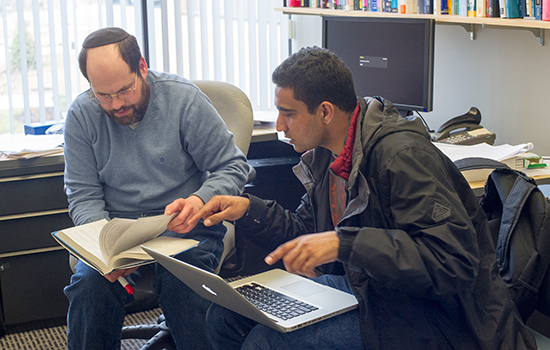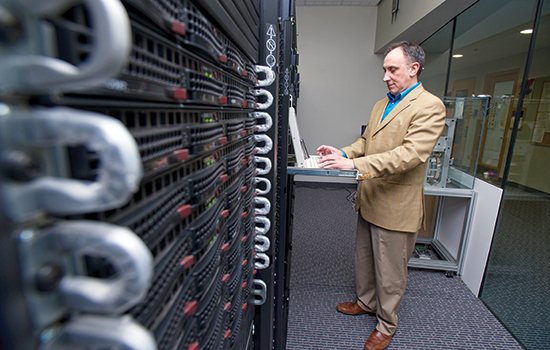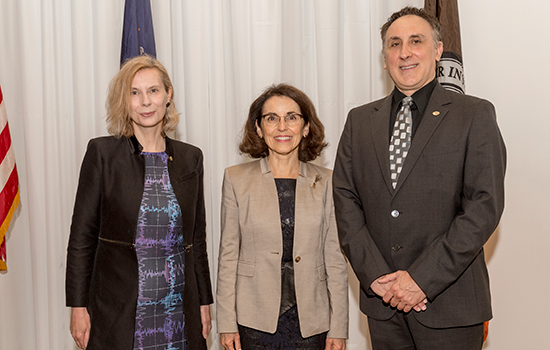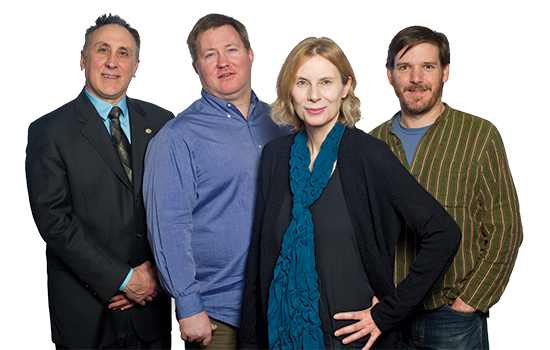Center grows into leader in space-time research
A. Sue Weisler
RIT faculty members Carlos Lousto, left, Richard O’Shaughnessy, Manuela Campanelli and John Whelan contributed to the breakthrough discovery of gravitational waves.
RIT’s contributions to the first direct detection of gravitational waves signifies its growing reputation for world-class astrophysics research.
Members of the university’s Center for Computational Relativity and Gravitation are part of the international collaboration affiliated with the Laser Interferometer Gravitational-wave Observatory, or LIGO. The scientific consortium, earlier this year, announced the landmark discovery of a gravitational wave passing through Earth.
RIT researchers on the LIGO team used theoretical calculations to validate the existence of gravitational waves and the black-hole collision that produced them, conducted gravitational wave analysis and estimated astrophysical parameters for the National Science Foundation-funded experiment.
Established in 2007, the center has grown from five to 26 members, including 10 faculty, plus administrative staff, postdoctoral researchers and students. Their complementary research revolves around Albert Einstein’s general theory of relativity and explores extreme astrophysical phenomena, gravitational wave analysis and scientific visualization. This RIT research center of excellence has won nearly $8 million in research funding from the NSF and NASA as well as allocations at national computing laboratories.
“When created, the Center for Computational Relativity and Gravitation was one of only a few centers of its kind,” said Manuela Campanelli, director of the center and professor in the School of Mathematical Sciences. “It’s a model that has been repeated at other universities. The center is now one of the largest and most renowned research groups in gravitational physics in the world.”
One of the leading founders of the LIGO project, Kip Thorne, was named to Time magazine’s 2016 list of “100 Most Influential People.” Thorne, the Feynman Professor of Theoretical Physics, Emeritus at Caltech, has followed astrophysics research at RIT.
“I am impressed by the research performed at the RIT Center for Computational Relativity and Gravitation,” Thorne said. “Members of the center have displayed amazingly good judgment in choice of research problems and remarkable skills in solving those problems. As a result, they are world leaders in extracting, from numerical simulations, major new insights into the dynamics of warped space-time, and they laid key foundations for the worldwide search for gravitational waves.”
Starting a center
RIT’s foray into astrophysics did not happen overnight. For the last decade, the RIT College of Science has steadily added to its astronomy faculty, an initiative started by former Dean Ian Gatley and continued, since 2010, by current Dean Sophia Maggelakis.
Campanelli credits RIT’s leadership for bringing her team to the university and for seeing the promise of LIGO. Several individuals have supported the center and LIGO research at RIT, including Gatley, Maggelakis, former RIT President Albert Simone and former Provost Stanley McKenzie.
“In 2008, President Bill Destler gave us new start-up funds to hire a faculty member in the area of gravitational wave research,” Campanelli said. “Provost Jeremy Haefner has also provided needed space to accommodate new post-doctoral researchers and faculty in the group.”
Destler’s support enabled Campanelli to add gravitational wave analyst John Whelan to the team. Whelan is now RIT’s principal investigator and liaison to the LIGO Scientific Collaboration.
Research at the RIT center builds on early efforts by Campanelli and Carlos Lousto, RIT professor in the School of Mathematical Sciences, to study black-hole mergers using computer simulations. The 40-year-old problem to simulate black holes orbiting, merging and producing gravitational waves required the solution of Einstein’s 10 interrelated strong field equations and access to unprecedented computer power to do the math.
Campanelli and Lousto—then post-doctoral researchers at the Max Plank Institute in Germany in 1998—broke the problem into smaller steps and modeled the final portion of the merger, or coalescence, for the first time using numerical relativistic techniques.
This specialized field of study grew from Einstein’s general theory of relativity. It uses sophisticated mathematics and supercomputers to solve equations that describe astrophysical phenomena capable of producing gravitational waves, like black holes, supernovae and compact neutron stars.
In 2005, Campanelli and Lousto, faculty members in physics and astronomy at the University of Texas Brownsville, and then post-doctoral researcher Yosef Zlochower solved Einstein’s equations that numerically describe black hole collisions. Using sophisticated mathematical modeling and high-powered computing, Campanelli’s team at UT Brownsville developed theoretical calculations that evolved black holes on computers from orbiting masses through coalescence and simulated the sought-after gravitational-wave signal.
They were one of three groups that year to present different solutions for simulating black hole mergers. Many scientists exploring gravitational wave physics adopted Campanelli’s “moving puncture” approach and replicated her research. (Her landmark model predicted the gravitational waves LIGO detected a decade later.)
At RIT, in 2006, Maggelakis, then head of the Department of Mathematics and Statistics, led the initiative to establish the School of Mathematical Sciences and to form a research center at RIT dedicated to computational modeling.
“The field of computational modeling has become a critical tool of research in science,” Maggelakis said. “It is a cross-disciplinary field, spanning applied mathematics, computer science and the physical sciences.”
Campanelli and Lousto’s research exemplifies the use of computational modeling for predicting the behavior of astrophysical phenomena. In 2007, Campanelli arrived at RIT with Lousto and Zlochower to form the RIT Center for Computational Relativity and Gravitation within the School of Mathematical Sciences.
The following year, the College of Science introduced a Ph.D. degree in astrophysical sciences and technology. The program brought together scientists from different disciplines within the college to explore general relativity and black holes, young and dying stars, galaxies and the technology to make new observations.
The center is also affiliated with the university’s eighth Ph.D. program in mathematical modeling—approved by the New York State Education Department and ready to launch in fall 2017—as well as three MS programs: applied and computational mathematics, computer science and data science.
“The new Ph.D. in mathematical modeling will be extremely important to faculty, researchers and students working together in both of our research centers—the Center for Computational Relativity and Gravitation and the Center for Applied and Computational Mathematics,” Maggelakis said. “There is a need for researchers trained in the theoretical basis for the numerical simulations of partial differential equations and with the practical experience only available through an extensive numerical research project. The CCRG has an established research program ideally suited for Ph.D. students in mathematical modeling.”
The center grew in 2009 with the arrival of Joshua Faber and Whelan, both associate professors in the School of Mathematical Sciences. More recent additions include Richard O’Shaughnessy, assistant professor in the School of Mathematical Sciences; Jason Nordhaus, assistant professor of science and math in the National Technical Institute for the Deaf; and Sukanya Chakrabarti, assistant professor in the School of Physics and Astronomy.
The American Physical Society elected Campanelli and Lousto fellows in 2009 and 2012, respectively. The prestigious recognition for their contributions to numerical relativity and for simulating binary black holes further elevated the center.
Faculty and students at the center participated in the 2015 centennial celebration of Einstein’s general theory of relativity by hosting seminars and producing videos about their research. The American Physical Society featured Campanelli’s breakthrough research in a collection of seminal papers that included work by Einstein, J.R. Oppenheimer and Stephen Hawking, among others.
Campanelli gave several talks about general relativity throughout 2015 and was one of three invited speakers at a special symposium hosted by the American Association for the Advancement of Science, one of the largest general scientific societies in the world and publisher of the journal Science.
Amidst centennial celebrations, faculty and students at the center remained quiet about news that would confirm Einstein’s 100-year-old theory. The gravitational wave observatory, LIGO, had detected a signal on Sept. 14, 2015, and the waveform neatly matched the simulation Campanelli and her team had predicted in 2005. Lousto and RIT postdoctoral researcher James Healy used the theoretical calculations to validate the signal. The RIT LIGO team and their collaborators spent five months confirming the findings before the news was announced on Feb. 11, 2016. The discovery was a double confirmation of Einstein’s theory and of Campanelli’s research.
“It’s not that we have only detected gravitational waves and statistically it makes sense, but they happened to be exactly what we predicted for the collision of black holes,” Lousto said.
What’s next
Student researchers take an active role at the center. Graduate students on the RIT LIGO team are among the co-authors of the landmark LIGO paper reporting the discovery of gravitational waves.
“More than a dozen Ph.D. students from the astrophysical sciences and technology program have been working with faculty at the Center for Computational Relativity and Gravitation in a variety of astrophysical domains,” Campanelli said.
She expects the number of graduate students in the center to increase with the growth of the astrophysics program. Undergraduate researchers also contribute to the center’s productivity.
“It is important to attract and educate students in the area of gravitational physics and have them experience the excitement of the discoveries about gravitational wave astronomy that will completely revolutionize the understanding of our universe,” Maggelakis said.
Monica Rizzo, a second-year student in the School of Physics and Astronomy, is on the RIT LIGO team. She works with O’Shaughnessy on models that simulate gravitational wave signals for colliding neutron stars, or collapsed stellar remnants. Although Rizzo did not contribute directly to the initial discovery, her research has helped advance techniques for interpreting future data.
“Working at the center has made my undergraduate experience unique,” Rizzo said. “It has been an incredibly rewarding experience and I feel I have learned a great deal both as a student and a researcher. Dr. Campanelli and Dr. O’Shaughnessy, along with other members of the CCRG and the LIGO collaboration, have inspired me to pursue astrophysics as a career path. I have gained a number of role models and aspire to be as hardworking and as successful as my mentors and colleagues.”
RIT’s Office of Sponsored Research has designated the Center for Computational Relativity and Gravitation as one of its five signature research areas that will receive $1 million over five years. The strategic investment will position Campanelli’s team to increase its external funding competitiveness and become leaders in gravitational wave and multimessenger astronomy, which combines information from gravitational waves and traditional astronomy’s electromagnetic spectrum.
“We will boost our current initiatives in key designated areas with strategic hires of postdoctoral researchers and visiting senior researchers to build a wide-spanning and tightly integrated program,” Campanelli said. “We will also pursue new research opportunities and play a role in developing next-generation gravitational wave detectors.”
Why the science matters
The first direct detection of gravitational waves from a binary black-hole source confirmed on Sept. 14, 2015, Einstein’s theory of gravity and introduced a new branch of physics—gravitational wave astronomy. Gravitational waves from a second pair of colliding black holes on Dec. 26, 2015, validated the landmark discovery. Advanced LIGO will continue to increase in sensitivity in subsequent runs and detect astronomical objects carrying fainter signals. Gravitational wave astronomy could unlock secrets of how massive stars evolve. The scope of gravitational wave astronomy will continue to widen as the international network of detectors becomes fully operational.
RIT’s LIGO Team
The LIGO Scientific Collaboration published its breakthrough discovery in Physical Review Letters, a journal of the American Physical Society, on Feb. 11. Six RIT researchers are among the co-authors. They are James Healy, post-doctoral research fellow; Carlos Lousto, professor in the School of Mathematical Sciences and an American Physical Society Fellow; Richard O’Shaughnessy, assistant professor in the School of Mathematical Sciences; John Whelan, associate professor in RIT’s School of Mathematical Sciences and principal investigator of RIT’s group in the LIGO Scientific Collaboration; and graduate students in RIT’s astrophysical sciences and technology program Jacob Lange and Yuanhao Zhang.
Other RIT members of the LIGO Scientific Collaboration include center director Manuela Campanelli, professor in the School of Mathematical Sciences and an American Physical Society Fellow; Hans-Peter Bischof, professor of computer science; and RIT students Ryan Hesse, Marc McClure, Jam Sadiq, Monica Rizzo and Jackson Henry ’16 (physics). Rizzo and Henry were co-authors of the second observation.
 Researcher Yosef Zlochower, left, is a key author with Manuela Campanelli and Carlos Lousto of the 2005 breakthrough research on binary black holes. Here, he confers with Jam Sadiq, a Ph.D. student, in the astrophysical sciences and technology program in the College of Science. A. Sue Weisler
Researcher Yosef Zlochower, left, is a key author with Manuela Campanelli and Carlos Lousto of the 2005 breakthrough research on binary black holes. Here, he confers with Jam Sadiq, a Ph.D. student, in the astrophysical sciences and technology program in the College of Science. A. Sue Weisler Carlos Lousto designed the NewHorizons and BlueSky supercomputer clusters in RIT’s Black Hole Lab to perform binary black-hole simulations. NewHorizons is dedicated to research in numerical relativity and computational relativistic astrophysics, while BlueSky supports interdisciplinary research at the frontiers of gravitational physics, relativistic astrophysics, advanced high performance computation and scientific visualization. A. Sue Weisler
Carlos Lousto designed the NewHorizons and BlueSky supercomputer clusters in RIT’s Black Hole Lab to perform binary black-hole simulations. NewHorizons is dedicated to research in numerical relativity and computational relativistic astrophysics, while BlueSky supports interdisciplinary research at the frontiers of gravitational physics, relativistic astrophysics, advanced high performance computation and scientific visualization. A. Sue Weisler Manuela Campanelli and Carlos Lousto with National Science Foundation Director France Córdova, center, who spoke at RIT’s commencement. Elizabeth Lamark/RIT Production Services
Manuela Campanelli and Carlos Lousto with National Science Foundation Director France Córdova, center, who spoke at RIT’s commencement. Elizabeth Lamark/RIT Production Services













